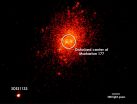(Press-News.org) MADISON, Wis. -- Each year, the planet balances its budget. The carbon dioxide absorbed by plants in the spring and summer as they convert solar energy into food is released back to the atmosphere in autumn and winter. Levels of the greenhouse gas fall, only to rise again.
But the budget has gotten bigger. Over the last five decades, the magnitude of this rise and fall has grown nearly 50 percent in the Northern Hemisphere, as the amount of the greenhouse gas taken in and released has increased. Now, new research shows that humans and their crops have a lot to do with it, highlighting the profound impact people have on the Earth's atmosphere.
In a study published Wednesday, Nov. 19, in Nature, scientists at Boston University, the University of New Hampshire, the University of Michigan, the University of Minnesota, the University of Wisconsin-Madison and McGill University show that a steep rise in the productivity of crops grown for food accounts for as much as 25 percent of the increase in this carbon dioxide (CO2) seasonality.
It's not that crops are adding more CO2 to the atmosphere; rather, if crops are like a sponge for CO2, the sponge has simply gotten bigger and can hold and release more of the gas.
With global food productivity expected to double over the next 50 years, the researchers say the findings should be used to improve climate models and better understand the atmospheric CO2 buffering capacity of ecosystems, particularly as climate change may continue to perturb the greenhouse gas budget.
"This is another piece of evidence suggesting that when we (humans) do things at a large scale, we have the ability to greatly influence the composition of the atmosphere," says UW-Madison's Chris Kucharik, a co-author of the study and professor in the College of Agricultural and Life Sciences Department of Agronomy and the Nelson Institute for Environmental Studies.
Since the 1960s in the Northern Hemisphere, maize (corn), wheat, rice and soybeans have seen a 240 percent spike in production, particularly concentrated in the midwestern U.S. and in Northern China, the study found.
But until this point, scientists missed the connection between crops and the CO2 seasonality increase.
"Global climate models don't represent the important details of agroecosystems and their management very well," says Kucharik.
It was fall 2013 when the study's lead authors at Boston University approached the UW-Madison scientist and asked him to lend his agricultural land management, carbon cycling and agricultural technology expertise to their examination of the cycle.
Kucharik helped the team determine how the amount of carbon absorbed by the leaves, stems, roots and food-portion of crops may have changed over time. He helped ensure the methodology the team used properly represented agricultural lands and the management practices that drive changes in the carbon balance.
The study found that, while the area of farmed land has not significantly increased, the production efficiency of that land has. Intensive agricultural management over the last 50 years has had a profound impact.
Kucharik attributes this to improvements in plant breeding, post-World War II fertilization innovations, irrigation and other human-powered technologies.
"You get more bang for your buck, more crop per drop," he says.
Cropland makes up just six percent of the vegetated, or green, area of the Northern Hemisphere and yet, it is a dominant contributor to the 50 percent increase in the CO2 seasonality cycle. This, despite the fact that forests and grasslands have also been more productive as the planet has warmed and growing seasons have lengthened.
"That's a very large, significant contribution, and 2/3 of that contribution is attributed to corn," says Kucharik. "Corn once again is king, this time demonstrating its strong influence on the seasonal cycle of atmospheric CO2."
Earlier work at UW-Madison enabled the research team to make the necessary calculations to incorporate agriculture into the new modeling approach, Kucharik says.
"The person that led the charge was Navin Ramankutty at SAGE (the Nelson Institute Center for Sustainability and the Global Environment), in Jon Foley's group in the late '90s and early 2000s," says Kucharik. "Those first global maps of agricultural land use over time came out of SAGE and the Nelson Institute."
INFORMATION:
Ramankutty, a co-author of the study, is now a geography professor at the University of British Columbia while Foley, not an author on the study, is now the executive director of the California Academy of Sciences.
CONTACT: Chris Kucharik, 608-890-3021, kucharik@wisc.edu
--Kelly April Tyrrell, ktyrrell2@wisc.edu, 608-262-9772
An international team of researchers analyzing decades of observations from many facilities, including NASA's Swift satellite, has discovered an unusual source of light in a galaxy some 90 million light-years away.
The object's curious properties make it a good match for a supermassive black hole ejected from its home galaxy after merging with another giant black hole. But astronomers can't yet rule out an alternative possibility. The source, called SDSS1133, may be the remnant of a massive star that erupted for a record period of time before destroying itself in a supernova ...
On an archaeology field trip in New Mexico as an undergraduate in 2006, Dana Bardolph noticed something that struck her as an odd gender imbalance: The professor leading the dig was a men, while the graduate assistant and all but two of the 14 undergrads were women.
"And it just got me thinking," Bardolph recalled. "Is this reflective of the profession as a whole, or is it an anomaly?"
The question stayed with her, and four years ago she decided to search for an answer. Her findings -- generated after digging through more than 4,500 peer-reviewed papers in 11 archaeology ...
TORONTO, November 19, 2014 - Today an international team of researchers announced the discovery of two new particles in the baryon family, which makes them cousins of the familiar proton and neutron. The LHCb collaboration at CERN, the European Organization for Nuclear Research, used CERN's Large Hadron Collider to make these discoveries.
The masses of these particles, named Xi_b'- and Xi_b*- had been predicted in a paper published in 2009 by York University Professor Randy Lewis and Richard Woloshyn, scientist at the TRIUMF Lab in Vancouver, using a supercomputer approach ...
Far more breast cancer patients are choosing to undergo mastectomy, including removal of both breasts, instead of choosing breast conservation surgery even when they have early stage disease that is confined to one breast, a Vanderbilt study shows. In the past decade, there have also been marked trends toward higher proportions of women opting for breast reconstruction.
The rates of increase were steepest among women with lymph node-negative and in situ (contained) disease.
This is a reversal of trends seen since the 1990s when breast conservation surgery (BCS) was ...
Delivering stem cell factor directly into damaged heart muscle after a heart attack may help repair and regenerate injured tissue, according to a study led by researchers from Icahn School of Medicine at Mount Sinai presented November 18 at the American Heart Association Scientific Sessions 2014 in Chicago, IL.
"Our discoveries offer insight into the power of stem cells to regenerate damaged muscle after a heart attack," says lead study author Kenneth Fish, PhD, Director of the Cardiology Laboratory for Translational Research, Cardiovascular Research Center, Mount Sinai ...
Tropical Storm Adjali started curving to the southwest on its trek through the Southern Indian Ocean when NASA's Aqua satellite passed overhead on Nov. 19.
The Moderate Resolution Imaging Spectroradiometer or MODIS instrument that flies aboard NASA's Aqua satellite captured a visible picture of Tropical Storm Adjali on Nov. 19 at 9:05 UTC (4:05 a.m. EST). The MODIS image showed that the storm began curving to the southwest, and despite slight weakening, thunderstorms circled around the low-level center.
Adjali was curving to the southwest as it continued to move along ...
Minimum legal drinking age legislation in Canada can have a major impact on young drivers, according to a new study from the Northern Medical Program at the University of Northern British Columbia (UNBC). Drivers just older than the legal age had a significant increase in motor vehicle crashes compared to those immediately under the restriction.
In the study, published this week in the American Journal of Preventive Medicine, Dr. Russ Callaghan and his research team looked at Quebec motor vehicle collision statistics between 2000 and 2012 which involved young drivers. ...
A physicist in Syracuse University's College of Arts and Sciences is the lead contributor to the discovery of two never-before-seen baryonic particles. The finding, which is the subject of a forthcoming article in Physical Review Letters (American Physical Society, 2014), is expected to have a major impact on the study of quark dynamics.
Steven Blusk, associate professor of physics, has identified particles known as Xi_b'- and Xi_b*-. Although the particles had been predicted to exist, nobody has seen them until now. The discovery is part of his ongoing work at the Large ...
The first issue of a new publication series from The Gerontological Society of America (GSA) called From Policy to Practice explores pain as a public health problem and takes a look at how various policies impact the care provided to patients in a range of practice settings. It also provides readers with an overview of provisions of the Affordable Care Act that address pain research, education, training, and clinical care -- as well as steps taken to implement those provisions.
"An Interdisciplinary Look at the Potential of Policy to Improve the Health of an Aging America: ...
Physician-researchers from the Cardiac Center at The Children's Hospital of Philadelphia (CHOP) presented new findings on pediatric cardiovascular disease at the American Heart Association's Scientific Sessions 2014 in Chicago. Among many other topics, they investigated using automated external defibrillators in infants, long-term cardiac risk in surgical survivors of the Fontan operations for congenital heart disease, and whether centers that perform more cardiac catheterizations tend to have better outcomes.
Pediatric cardiologist Yoav Dori, M.D., Ph.D., delivered ...




